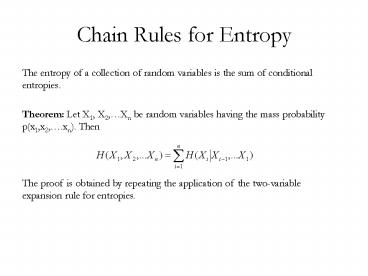Chain Rules for Entropy - PowerPoint PPT Presentation
Title:
Chain Rules for Entropy
Description:
Chain Rules for Entropy The entropy of a collection of random variables is the sum of conditional entropies. Theorem: Let X1, X2, Xn be random variables having the ... – PowerPoint PPT presentation
Number of Views:77
Avg rating:3.0/5.0
Title: Chain Rules for Entropy
1
Chain Rules for Entropy
- The entropy of a collection of random variables
is the sum of conditional entropies. - Theorem Let X1, X2,Xn be random variables
having the mass probability p(x1,x2,.xn). Then
The proof is obtained by repeating the
application of the two-variable expansion rule
for entropies.
2
Conditional Mutual Information
- We define the conditional mutual information of
random variable X and Y given Z as
Mutual information also satisfy a chain rule
3
Convex Function
- We recall the definition of convex function.
- A function is said to be convex over an interval
(a,b) if for every x1, x2 ?(a.b) and 0? ? 1,
A function f is said to be strictly convex if
equality holds only if ?0 or ?1. Theorem If
the function f has a second derivative which is
non-negative (positive) everywhere, then the
function is convex (strictly convex).
4
Jensens Inequality
- If f is a convex function and X is a random
variable, then
Moreover, if f is strictly convex, then equality
implies that XEX with probability 1, i.e. X is a
constant.
5
Information Inequality
- Theorem Let p(x), q(x), x ??, be two probability
mass function. Then
With equality if and only if
for all x.
Corollary (Non negativity of mutual
information) For any two random variables, X, Y,
With equality f and only if X and Y are
independent
6
Bounded Entropy
- We show that the uniform distribution over the
range ? is the maximum entropy distribution over
this range. It follows that any random variable
with this range has an entropy no greater than
log?. - Theorem H(X) log?, where? denotes the
number of elements in the range of X, with
equality if and only if X has a uniform
distribution over ?. - Proof Let u(x) 1/? be the uniform
probability mass function over ? and let p(x) be
the probability mass function for X. Then - Hence by the non-negativity of the relative
entropy,
7
Conditioning Reduces Entropy
- Theorem
- with equality if and only if X and Y are
independent. - Proof
- Intuitively, the theorem says that knowing
another random variable Y can only reduce the
uncertainty in X. Note that this is true only on
the average. Specifically, H(XYy) may be
greater than or less than or equal to H(X), but
on the average
8
Example
- Let (X,Y) have the following joint distribution
- Then H(X)(1/8, 7/8)0,544 bits, H(XY1)0 bits
and H(XY2)1 bit. We calculate H(XY)3/4
H(XY1)1/4 H(XY2)0.25 bits. Thus the
uncertainty in X is increased if Y2 is observed
and decreased if Y1 is observed, but uncertainty
decreases on the average.
X
1 2
Y
1 0 3/4 2 1/8 1/8
9
Independence Bound on Entropy
- Let X1, X2,Xn are random variables with mass
probability p(x1, x2,xn ). Then - With equality if and only if the Xi are
independent. - Proof By the chain rule of entropies
- Where the inequality follows directly from the
previous theorem. We have equality if and only if
Xi is independent of X1, X2,Xn for all i, i.e.
if and only if the Xis are independent.
10
Fanos Inequality
- Suppose that we know a random variable Y and we
wish to guess the value - of a correlated random variable X. Fanos
inequality relates the probability - of error in guessing the random variable X to its
conditional entropy - H(XY). It will be crucial in proving the
converse to Shannons channel - capacity theorem. We know that the conditional
entropy of a random variable X given another
random variable Y is zero if and only if X is a
function of Y. Hence we can estimate X from Y
with zero probability of error if and only if
H(XY) 0. - Extending this argument, we expect to be able to
estimate X with a - low probability of error only if the conditional
entropy H(XY) is small. - Fanos inequality quantifies this idea. Suppose
that we wish to estimate a - random variable X with a distribution p(x). We
observe a random variable - Y that is related to X by the conditional
distribution p(yx).
11
Fanos Inequality
- From Y, we calculate a function g(Y) X , where
X is an estimate of X and takes on values in X.
We will not restrict the alphabet X to be equal
to X, and we will also allow the function g(Y) to
be random. We wish to bound the probability that
X ? X. We observe that X ? Y ? X forms a Markov
chain. Define the probability of error Pe
PrX X. - Theorem
- The inequality can be weakened to
- Remark Note that Pe 0 implies that H(XY) 0
as intuition suggests.































